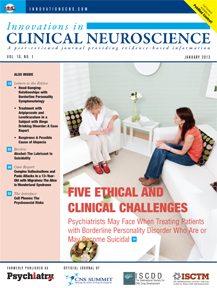 Vincenzo M. Romeo, MD; Antonio Bruno, MD, PhD; Umberto Micò, MD, PhD; Rocco A. Zoccali, MD; and Maria Rosaria A. Muscatello, MD, PhD
Vincenzo M. Romeo, MD; Antonio Bruno, MD, PhD; Umberto Micò, MD, PhD; Rocco A. Zoccali, MD; and Maria Rosaria A. Muscatello, MD, PhD
Drs. Romeo, Bruno, Micó, Zoccali, and Musca are with the Section of Psychiatry, Department of Neurosciences, Psychiatric and Anaesthesiological Sciences, University of Messina, Italy; Dr. Romeo is also with Therapeutic Community (C.T., “Ce.Re.So.” — Reggio Calabria, Italy
Innov Clin Neurosci. 2013;10(1):11–12
Funding and disclaimers: There was no funding for this study and no reported conflicts of interest by the authors.
Binge drinking disorder is defined as consuming consecutive alcoholic beverages in a limited period of time on one or more occasions within the past six months. The National Institute on Alcohol Abuse and Alcoholism (NIAAA) recently proposed the following definition of a binge episode: “A binge is a pattern of drinking alcohol that brings blood alcohol concentration (BAC) to 0.08g/dL or above. This pattern typically corresponds to consuming five or more drinks (male) in approximately two hours.”[1]
Levetiracetam is a newer generation antiseizure medication; its efficacy and tolerability as adjunctive therapy in adult patients with alcohol dependence has been demonstrated in four pivotal clinical trials. Aripiprazole is a partial D2 and 5-HT1A agonist, and a 5-HT2A receptor antagonist. Pharmacological studies show that, depending on the cellular milieu, aripiprazole can behave as a partial agonist, a full agonist, or an antagonist at the dopamine D2 receptor; this mechanism of action may be particularly relevant during hypodopaminergic states in the mesolimbic area associated with alcohol withdrawal. In animal models, its role in reducing alcohol preference and reinforcement has been explored, and aripiprazole has been proposed as a potential pharmacotherapy for alcohol dependence in humans.[2]
Case report. We report a case of binge drinking disorder treated with aripiprazole and levetiracetam. The patient was a 32-year-old Italian man referred to our unit in January 2010 for the persistence of alcohol dependence disorder and maladjustment disorder. After symptomatological onset (alcohol abuse, irritability, impulsiveness), dated at the age of 22 years, the patient maintained an acceptable level of functioning until the age of 28 years, when he displayed marked impulsivity and impulse discontrol, anger outbursts, and binge drinking. The patient used to drink alcoholic beverages at work, and for this reason he was dismissed. When he was brought to our unit, he was taking olanzapine 20mg/day, citalopram 20mg /day, topiramate 200mg/day, and diazepam 15mg/day.
Beyond compulsive overdrinking (binge type), at baseline, depression and anxiety were present; his relationships were superficial and characterized by impulsivity and intense anger.
The patient underwent laboratory investigations (including biochemistry; liver, renal and thyroid function tests; and electrolytes, iron, and transferrin levels), and neurological examination.
The following psychometric instruments were administered: Hamilton Rating Scale for Depression (HAM-D), Hamilton Anxiety Scale (HAM-A), and Obsessive Compulsive Drinking Scale (OCDS). Total scores at baseline were as follows: HAM-D=32, HAM-A=37, OCDS=22. Although he was diagnosed, according to NIAAA criteria, with binge drinking disorder, due to persistent symptoms and nonresponse to previous treatments, pharmacological treatment was modified by the progressive reduction until suspension of olanzapine, citalopram, topiramate, and diazepam and the introduction of levetiracetam at the starting dose of 500mg/day up to the maximum dose of 2,000mg/day, and aripiprazole 10mg/day.
At six months follow-up, the treatment produced a significant improvement in mood and in sociorelational functioning; the main result was the cessation of binge drinking, with no emergence of withdrawal symptoms. Moreover, he was readmitted to work. After six months of treatment, a further psychodiagnostic assessment evidenced the following results: HAM-D=17, HAM-A=12, OCDS=6. At one-year follow-up, the improvement in psychopathology was further maintained and consolidated without any binge drinking event reported.
Discussion. Here we report a case of binge drinking successfully treated with a combination of levetiracetam and aripiprazole. Binge is defined as a period of uncontrolled or excessive consumption of either food or alcohol associated with craving, impulsive, and compulsive behaviors. Impulsivity has been examined as an important personality correlate of individuals who engage in binging, and it has been conceptualized as a multidimensional trait consisting of urgency, sensation seeking, lack of planning, and lack of persistence.[3]
A number of indications confirmed that anticonvulsant medications are potentially useful therapies for alcohol dependence, as evidenced with topiramate, which has been shown to reduce drinking and promote abstinence in actively drinking individuals with alcohol dependence. Our results suggest that levetiracetam is a safe and generally well-tolerated medication that may have beneficial effects on alcohol use and associated anxiety symptoms in alcohol dependence; in binge drinking disorder, an anti-impulsive action stronger than that of topiramate may be hypothesized. Levetiracetam has also been shown to cause less cognitive function impairment than topiramate.[4]
Aripiprazole, as a partial D2 agonist, can reduce alcohol reinforcement and craving without producing substantial extrapyramidal adverse effects. Aripiprazole can be useful and safe in the treatment of heavy drinking. In particular, it may reduce the rewarding and reinforcing effects of alcohol, blocking alcohol cue-induced activation in the nucleus accumbens.[5]
In conclusion, we considered the treatment of binge drinking disorder with aripiprazole and levetiracetam coadministration as an encouraging option, which appears to be safe and effective. Further investigations should explore the efficacy and safety of this combination strategy in patients affected by binge eating disorder.
References
1. Wechsler H, Nelson TF. Binge drinking and the American college students: what’s five drinks? Psychol Addict Behav. 2001;15:287–291.
2. Martinotti G, Nicola MD, Janiri L. Efficacy and safety of aripiprazole in alcohol dependence. Am J Drug Alcohol Abuse. 2007;33:393–401.
3. Whiteside SP, Lynam DR. The five factor model and impulsivity: using a structural model of personality to understand impulsivity. Person Indiv Dif. 2001;30:669–689.
4. Gomer B, Wagner K, Frings L,
et al. The influence of antiepileptic drugs on cognition: a comparison of levetiracetam with topiramate. Epilepsy Behav. 2007;10:
486–494.
5. Myrick H, Anton RF, Li X, et al. The effect of aripiprazole on cue-induced brain activation in alcoholics. Neuropsychopharmacology. 2006;31:S90.




